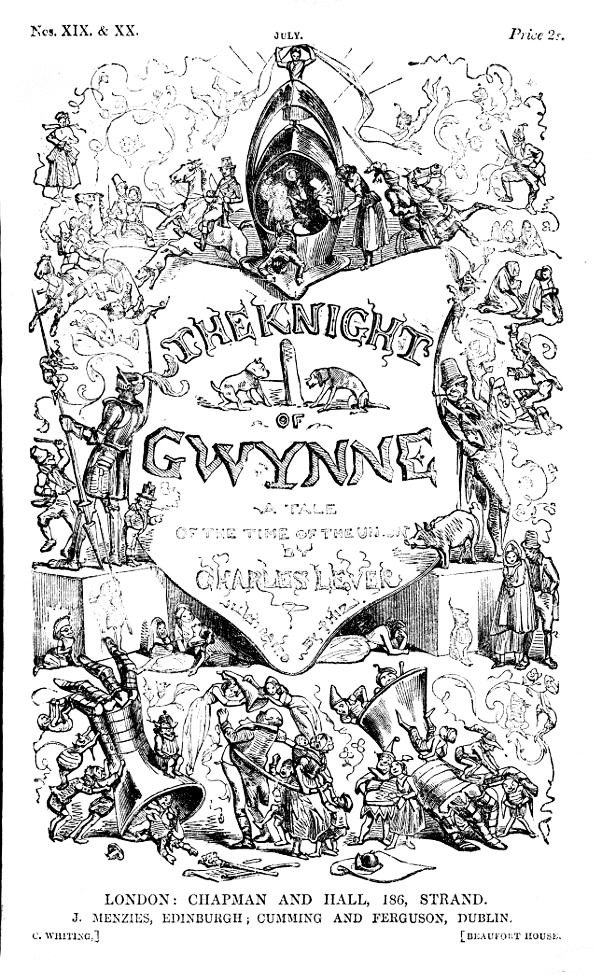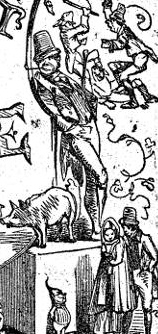

The Engraved Wrappers by Phiz (Hablot K. Browne). Second and nineteenth instalment wrappers for Charles Lever's The Knight of Gwynne; A Tale of the Time of the Union, 21.1 cm high by 13.1 cm wide (8 ¼ by 5 ¼ inches), vignetted, full-page wood-engraving for Part Two (Chapters V-IX) and Parts Nineteen-Twenty (Chapters LXXII-LXXV (January 1846 and July 1847). Amidst a huge number of allegorical figures and objects, most prominently the gigantic Knight's steel helmet at the top and the huge armoured gloves at the bottom, the February wrapper reads: "No. II. February. Price 1 s. The Knight / of/ Gwynne / A Tale / of the Time of the Union by Charles Lever. / Illustrated by Phiz. / London: Chapman and Hall, 186, Strand. / J. Menzies, Edinburgh; J. Cumming, Dublin." [Click on the illustration to enlarge it.]
The Wrapper, the Engraved Title-Page, and Lever's 1872 Remarks

Right: The engraved title-page for the nineteenth and final instalment (July, 1847).
I tried to display the effect of this strange teaching on the mind of a cultivated gentleman when describing the Knight of Gwynne. I endeavored to show the "Irishry" of his nature was no other than the play of those qualities by which he appreciated his countrymen and was appreciated by them. So powerful is this sympathy, and so strong the sense of national humor through all classes of the people, that each is able to entertain a topic from the same point of view as his neighbor, and the subtle équivoque in the polished witticism that amuses the gentleman is never lost on the untutored ear of the unlettered peasant. Is there any other land of which one can say as much?
If this great feature of attractiveness pertains to the country and adds to its adaptiveness as the subject of fiction, I cannot but feel that to un-Irish ears it is necessary to make an explanation which will serve to show that which would elsewhere imply a certain blending of station and condition, is here but a proof of that widespread understanding by which, however divided by race, tradition, and religion, we are always able to appeal to certain sympathies and dispositions in common, and feel the tie of a common country.
At the period in which I have placed this story the rivalry between the two nations was, with all its violence, by no means ungenerous. No contemptuous estimate of Irishmen formed the theme of English journalism; and between the educated men of both countries there was scarcely a jealousy that the character which political contest assumed later on, changed much of this spirit and dyed nationalities with an amount of virulence which, with all its faults and all its shortcomings, we do not find in the times of the Knight of Gwynne.
CHARLES LEVER.
Trieste, 1872.
Commentary: The Allegorical Wrapper Design

Although the style of the wrapper is much the same as that of the book's engraved-title, it was executed a year-and-a-half earlier, and therefore is not informed by a complete reading of the nineteen-part novel in serial. As had been the case for Phiz's complex designs for the monthly wrappers of Dickens's serialisations in the 1830s and 1840s, Phiz shows a multitude of figures that bear little specific reference to the actual settings and characters of the novel since he had yet to read beyond the first few chapters. One thing he knew: The Knight of Gwynne is set in Ireland at the beginning of the nineteenth century and involves both serious and comic Irish types: Paddy the peasant, the Anglo-Irish squire, the professional classes (physicians and lawyers), all wearing clothing characteristic of the Regency. Imps, knights, and a great many shillelagh-wielding and dancing peasants, clowns, children, and pipe-smoking layabouts dominate the cast, but none has specific relevance to the story. The most obvious difference between Phiz's buff-coloured wrappers for The Knight of Gwynne and Dickens's novels is colour: Dickens always insisted upon green, ironically, a more suitable colour for the wrappers of Lever's Irish novels. The wrappers and the engraved title have publication significance in that they mark the first time that a Lever appeared under the Chapman and Hall imprint rather than that of William Curry, Dublin, who brought out Lever's first four books (1839-1844).
Left: The details of a pipe-smoking "Paddy" and his pig, and a young couple.
The Coloured Wrappers for Five of Dickens's Serialised Novels, 1838-1850





The various serial wrappers for Dickens's early novels: Monthly Wrapper Part 2 for Master Humphrey's Clock (1840); Wrapper No. 4 for Martin Chuzzlewit (1844); Cover No. VII for monthly parts of Dombey and Son (1846); Wrapper No. 13 for Nicholas Nickleby (1838-39); and Wrapper No. XV (July 1850) for David Copperfield (1849-50).
Related Material
Scanned images and text by Philip V. Allingham. [You may use these images without prior permission for any scholarly or educational purpose as long as you (1) credit the person who scanned them and (2) link your document to this URL in a web document or cite the Victorian Web in a print one.]
Bibliography
Buchanan-Brown, John. Phiz! Illustrator of Dickens' World. New York: Charles Scribner's Sons, 1978.
Lester, Valerie Browne Lester. Chapter 11: "'Give Me Back the Freshness of the Morning!'" Phiz! The Man Who Drew Dickens. London: Chatto and Windus, 2004. Pp. 108-127.
Lever, Charles. The Knight of Gwynne; A Tale of the Time of the Union. London: Chapman and Hall, serialised January 1846 through July 1847.
Lever, Charles. The Knight of Gwynne. Illustrated by Phiz [Hablột Knight Browne]. Novels and Romances of Charles Lever. Vol. I and II. In two volumes. Project Gutenberg. Last Updated: 28 February 2018.
Steig, Michael. Chapter Four: "Dombey and Son: Iconography of Social and Sexual Satire." Dickens and Phiz. Bloomington: Indiana U. P., 1978. Pp. 86-112.
Stevenson, Lionel. Chapter IX, "Nomadic Patriarch, 1845-1847." Dr. Quicksilver: The Life of Charles Lever. London: Chapman and Hall, 1939. Pp. 146-164.
_______. "The Domestic Scene." The English Novel: A Panorama. Cambridge, Mass.: Houghton Mifflin and Riverside, 1960.
Created 10 July 2023 Updated 18 July 2023